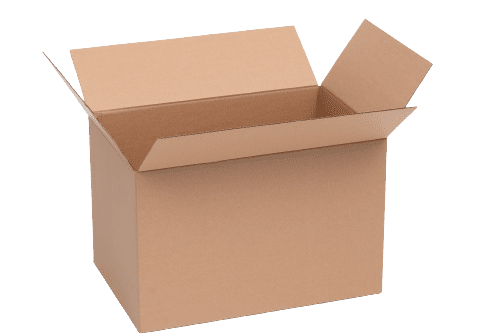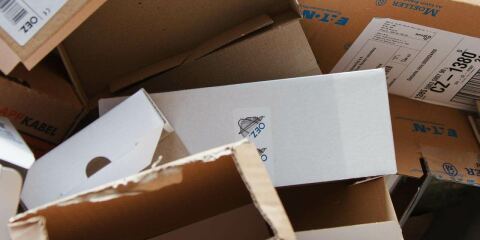There’s no way around it – moving or shipping items locally or long distance means the time will come when you have to pack. And packing means you’ll need supplies like boxes, tape, bubble wrap, and markers.
We understand how tempting it can be to save money by using free grocery store boxes and old newspapers to move your belongings. Moving can be expensive, after all! We’re all for pinching those pennies when possible, and we firmly believe there are good opportunities to use free supplies. But there are also times when it pays to invest in fresh, unused moving supplies. In some cases, using flimsy materials can even wind up costing you more in the long run.
Let’s look at some packing supply options and talk about when it’s okay to reuse them and when you should buy new.
Boxes
Boxes – they’re everywhere. They’re at the grocery store, on the side of the road and in department stores. They’re at schools, book stores, and restaurants. It isn’t hard to find used boxes. The question is, are they strong enough to hold up during transport?
Generally, used boxes are best used for lighter, more durable items. Because they are stronger, new boxes are recommended for heavier, fragile, or larger items.
When to reuse free boxes:
- When you need a variety of shapes and sizes
- When you need to pack lightweight items, like pillows and socks
- When you need to pack lower-value items, like dish towels and tupperware
TSI TIP: Spirit and wine boxes can be used to pack heavier items because they are built more sturdily than regular grocery store boxes.
When to buy new moving boxes:
- When you’re shipping items via freight, buy new boxes because they’re blank on the outside and easier to label
- If you’re moving out of state – you’ll want reliable boxes that can hold up during long distance moves
- Use new boxes for better protection while moving fragile items
- Use new boxes for heavy items, like books, dishes and electronics
- If you’re packing clothes in boxes, you’ll want to buy clean new boxes
Bubble Wrap
Anything breakable, or items that could easily be scratched, are best protected by using new bubble wrap. You can reuse old bubble wrap, but it might not keep your things as safe, particularly if the bubbles have been popped. If you do reuse old bubble wrap, we recommend doubling up on layers for added protection.
If you choose to buy new bubble wrap, you have several options:
- Limited- or low-grade bubble wrap provides less padding protection, but can help you avoid superficial damage like scratches.
- General bubble wrap (the most common) is made with a medium-weight plastic. While not as tough as high-grade bubble wrap, general bubble wrap is strong enough to withstand most shipping accidents.
- High-grade bubble wrap, aka “strong grade”, won’t "pop" as easily, which makes it ideal for wrapping heavy items, or times when there’s a risk of the item being dropped.
- Anti-static bubble wrap is best used to protect your electronics, like cell phones, computers, stereo equipment, and televisions.
- FDA-grade bubble wrap is made for use with foods you don’t want bruised and beaten while in transit. Use it to move things like fresh fruit, carbonated beverages, and eggs.
- Temperature-controlled bubble wrap is designed to help maintain the temperature of the items being shipped. Use it for things like wine, non-perishable foods, and aerosols.
Check out our bubble wrap sizing chart for more advice on choosing the right grade.
Paper
Paper – whether it’s new packing paper or old newspapers – is often used to wrap up glassware and separate plates. It can also be stuffed into empty spaces to prevent items from moving around inside the box. Paper doesn’t provide as much protection from damage as bubble wrap, but it can help to avoid chipping and scratching, and it might be a bit cheaper.
Should you buy packing paper or use old free newspapers? Free paper is OK in most cases. Just be careful – the ink can easily transfer to your belongings, so don’t pack anything you need to keep clean. Fresh packing paper is always recommended for wrapping delicate items like artwork, dishware, or other glass items.
Towels & Sheets
Using linens to wrap up your belongings is more than a money-saving hack, it also saves you from having to pack them in extra boxes.
Towels are great for packing toiletries like shampoo and conditioner, liquid soap, and cleaning supplies. If anything leaks during the move, the towel will absorb the moisture and keep the box dry and sturdy. Towels also make clean up easier because you can just toss them right into the wash.
Sheets are great for wrapping large items that you don’t want to be scratched, like wall art, table tops, and chair legs. They can also be used to provide extra cushioning to the bottom and top of boxes. And you can use small hand towels and face cloths to wrap knick knacks and accessories (like remote controls and computer accessories).
Conclusion
Every situation has its own set of unique needs, so there really isn’t a one-size-fits-all solution when it comes to packing. Use these tips as a guideline and choose the best options for your move. No matter which options you choose, once you've collected all your moving supplies, you can start packing! Check out our packing guide for more helpful tips.
Get Packing!
Read our room-by-room packing guide for expert advice on
packing every room in your home.





